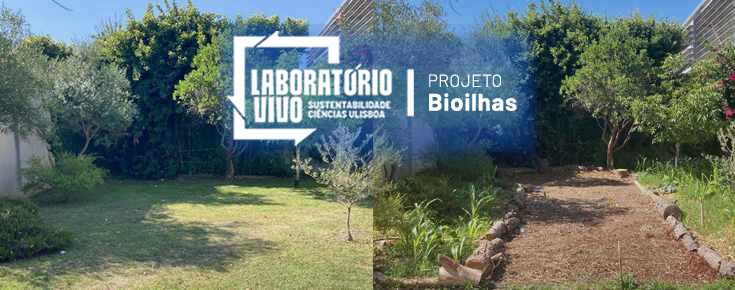

What is a Bioisland?
Born from a long-standing desire to transform urban public spaces, Bioislands propose the conversion of traditional green areas into biodiverse ecosystems open for the free use of the surrounding community. Instead of vast, sterile, and exposed spaces like lawns, Bioislands create clearings surrounded by dense vegetation, creating a more inviting, peaceful, and comfortable environment for the FCUL campus. Their epithet, "Biodiverse Classrooms," arises from the need to increase the availability of spaces for outdoor teaching, especially for Biological Sciences. As zones of slow and gradual intervention, Bioislands aim to co-create the ecosystem by involving all parties in the project. Furthermore, they provide an opportunity for students to feel like they are part of the campus's construction and evolution, fostering a sense of responsibility for the spaces they inhabit.
In summary, Bioislands are multifunctional spaces that (1) provide an opportunity for scientific activities in the context of education for various courses related to environmental and sustainability areas (academic/scientific function); (2) support urban biodiversity on campus (ecological function); (3) promote outdoor leisure spaces that enhance mental health and connect people with nature (social function); and (4) disseminate information/knowledge and raise awareness in the community about the importance of these new green spaces in an urban context (educational/pedagogical function).
How did we get here?
The 2023 edition of the Ideas for Sustainability in Science Contest served as the catalyst for the conception of this project. HortaFCUL responded to the challenge posed by the faculty, proposing to continue its mission in renewing paradigms related to the planning of urban living systems. The proposal won an honorable mention in the competition for "considering that it has great potential by adapting current green spaces with low utility." Its execution in less than two months was made possible through a partnership formed with the LIFE Desert Adapt project (LDA), through the Association for the Defense of Mértola Heritage (ADPM), which coordinated the project in Portugal, with FCUL as a research partner. The LDA aimed to implement climate change adaptation measures through the densification of native vegetation in areas vulnerable to desertification, such as the Alentejo region. As the project nears its end this year, the surplus plants that were not used in the study cases were generously donated to HortaFCUL by Filipe Silva and Miguel Ribeiro from ADPM (former FCUL students and former guardians of HortaFCUL) to be applied in one of the campus spaces. This extraordinary donation provided approximately 2,000 native plants characteristic of more drought-resistant ecosystems.
Bioislands? Why?
The exponential growth of urban populations in recent decades has led to an increase in the environmental impact of cities, both in the degradation and destruction of surrounding biodiversity and in human health itself. Additionally, the radical transformation of space resulting from urban expansion increases the vulnerability of the territory to extreme weather phenomena, such as floods (excessive soil sealing) or heatwaves (heat-absorbing surfaces). At the local level, Lisbon is the seventh most exposed European city to heatwaves. One of the most consensus-driven measures to combat the effects of these disturbances is the creation and expansion of green spaces. In addition to the clear benefits that green areas bring in terms of regulation (improved air quality), culture (recreational spaces), and support (biodiversity anchors), these places have a disproportionate impact on people's mental health: nearby nature is a public health issue.
According to researcher Cecil Konijnendijk, co-founder of the Nature Based Solutions Institute (NBSI), cities should follow the 3-30-300 rule regarding the management of their green spaces: every citizen should be able to see at least 3 trees from their window, live in a neighborhood with a minimum of 30% vegetative cover, and be within 300m or less of a larger green space, be it a garden or a park. Lisbon is far from meeting these goals: 70% of its population has poor access to green spaces, ranking 653rd in Europe in terms of preventable deaths if there were a real commitment to the impact of these areas on people's quality of life. Following the 3-30-300 rule, only 2% of buildings in Lisbon meet its conditions. These numbers must be mitigated with the implementation of concrete and simple solutions. Universities should be places of innovation and the introduction of new principles to civil society, and FCUL should continue its mission by directly applying these approaches on its campus, showing that such approaches are possible in other parts of the city and even in other urban contexts.

Workshop on planting biodiverse forests
On the weekend of July 1st and 2nd, the guardians of HortaFCUL, together with Filipe Silva and Miguel Ribeiro from ADPM, organized a workshop on planting dense and biodiverse forests in two grassy areas at FCUL. During these two days of activities, 35 volunteers from different backgrounds participated. The method followed was adapted from the experience of the LIFE Desert Adapt project, involving the creation of nests with one tree and four shrubs. Planting holes were dug and subsequently covered with cardboard (to prevent excessive grass growth), compost, and wood chips (ground cover). In the smaller Bioisland (near C5), a generous sowing of annual production plants (pumpkin, corn, beans, peas, among others) was also added to create a microclimate conducive to plant survival. ADPM's selection included 30 different species of native flora from Portugal, including cork oaks (Quercus suber), holm oaks (Quercus ilex), carob trees (Ceratonia siliqua), hawthorns (Crataegus monogyna), almond trees (Prunus dulcis), beech trees (Quercus faginea), or buckthorns (Rhamnus alaternus), to name a few. All these plants will form the body of the forest surrounding the clearings, where benches and tables will be available for the community's free enjoyment.
Project Coordinator: António Vaz Pato
Project members: Beatriz Vicente, David Avelar, Filipe Silva, Florian Ulm, Francisco Oliveira, Miguel Ribeiro
Photo credit: Beatriz Vicente e Diogo Ribeiro
For further information, contact sustentabilidade@ciencias.ulisboa.pt.

